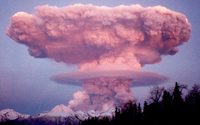6.9: Sources of Lithogenous Sediments- Continental Weathering and Erosion
- Page ID
- 9986
Sources of Lithogenous Sediments: Continental Weathering and Erosion
Rocks on or near the surface are exposed to physical and chemical interactions with air and water. The breakdown of earth materials due to exposure is called weathering. Weathering produces sediments; erosion moves sediments.
Lithogenous sediments are solid fragments of inorganic or organic material that come from the weathering of rock. On land and under water sediments are subjected to gravitation forces pulling them downslope. Erosion is the mechanical and chemical processes of weathering, wearing or grinding away materials on a landscape by the action of wind, flowing water, or glacial ice. Deposition is the process of sediments settling and accumulating from a moving fluid (wind, water, or ice). Once sediments have accumulated in a stable setting they can gradually undergo compaction and cementation to form sedimentary rocks.
Sediments can be eroded, transported, and deposited, often over and over again. Most sedimentary deposits preserve evidence about how, when, where, and why they were deposited!
 Figure 6.25. Volcanic eruptions can produce large volumes of ash and other debris that can be eroded, transported, and deposited as marine sediments.
Figure 6.25. Volcanic eruptions can produce large volumes of ash and other debris that can be eroded, transported, and deposited as marine sediments.


